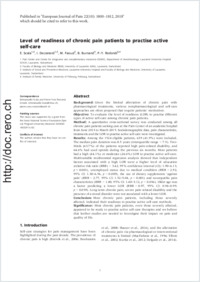Level of readiness of chronic pain patients to practise active self-care
- Scala, E. Pain Center and Center for integrative and complementary medecine (CEMIC), Department of Anesthesiology, Lausanne University Hospital (CHUV), Lausanne, Switzerland - Faculty of Biology and Medicine (FBM), University of Lausanne (UNIL), Lausanne, Switzerland
- Decosterd, I. Pain Center and Center for integrative and complementary medecine (CEMIC), Department of Anesthesiology, Lausanne University Hospital (CHUV), Lausanne, Switzerland - Faculty of Biology and Medicine (FBM), University of Lausanne (UNIL), Lausanne, Switzerland
- Faouzi, M. Institute of Social and Preventive Medicine, Lausanne University Hospital and Faculty of Biology and Medicine, University of Lausanne, Lausanne, Switzerland
- Burnand, B. Institute of Social and Preventive Medicine, Lausanne University Hospital and Faculty of Biology and Medicine, University of Lausanne, Lausanne, Switzerland
- Rodondi, Pierre-Yves Institute of Social and Preventive Medicine, Lausanne University Hospital and Faculty of Biology and Medicine, University of Lausanne, Lausanne, Switzerland
-
01.11.2018
Published in:
- European Journal of Pain. - 2018, vol. 22, no. 10, p. 1800–1812
English
Background Given the limited alleviation of chronic pain with pharmacological treatments, various nonpharmacological and self-care approaches are often proposed that require patients’ motivation. Objective To evaluate the level of readiness (LOR) to practise different types of active self-care among chronic pain patients. Method A quantitative cross-sectional survey was conducted among all chronic pain patients seeking care at the Pain Center of an academic hospital from June 2013 to March 2015. Sociodemographic data, pain characteristics, treatments and the LOR to practise active self-care were investigated. Results Among the 1524 eligible patients, 639 (41.9%) were included. The median pain duration was 8.5 years (interquartile range = 7.5). Two-thirds (63.7%) of the patients reported high pain-related disability, and 64.6% had used opioids during the previous six months. Most patients had a high (44.1%) or moderate (24.6%) LOR to practise active self-care. Multivariable multinomial regression analysis showed that independent factors associated with a high LOR were a higher level of education (relative risk ratio (RRR) = 3.42, 95% confidence interval (CI): 1.90–6.13, p < 0.001), unemployed status due to medical condition (RRR = 2.92, 95% CI: 1.30–6.56, p = 0.009), the use of dietary supplements ‘against pain’ (RRR = 2.77, 95% CI: 1.52–5.04, p = 0.001) and neuropathic pain characteristics (RRR = 1.80, 95% CI: 1.40–3.12, p = 0.036). Older age was a factor predicting a lower LOR (RRR = 0.97, 95% CI: 0.94–0.99, p = 0.039). Long-term chronic pain, severe pain-related disability and the presence of a mood disorder were not associated with a lower LOR. Conclusion Most chronic pain patients, including those severely affected, indicated their readiness to practise active self-care methods. Significance Most chronic pain patients, even those severely affected, appeared to be ready to practise active self-care therapies and we believe that further studies are needed to investigate their impact on pain and quality of life.
- Faculty
- Faculté des sciences et de médecine
- Department
- Master en médecine
- Language
-
- English
- Classification
- Medicine
- License
- License undefined
- Identifiers
-
- RERO DOC 323406
- DOI 10.1002/ejp.1276
- Persistent URL
- https://folia.unifr.ch/unifr/documents/307233
Other files
Statistics
Document views: 47
File downloads:
- rod_lrc.pdf: 149
- rod_lrs_sm.pdf: 128

